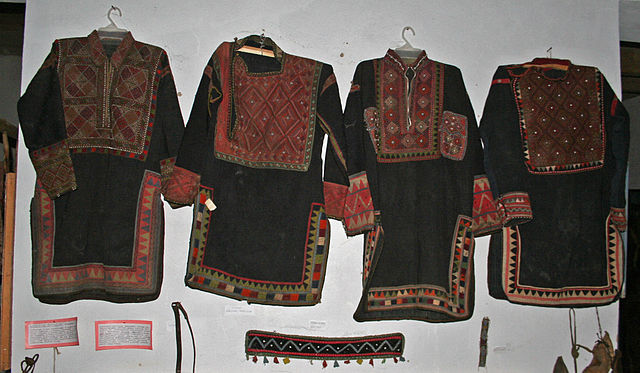The traditional dresses from the Caucasus keep many similarities between each other, yet every one of them is still unique and shows the heritage and culture of the country it represents. These cultures have survived through foreign occupations and therefore are proud to show their roots through these beautiful traditional dresses.

The traditional dresses of Armenia are very colorful and diversified. The men’s clothes are traditionally made of cotton and wool, with collared shirts that have silky details. The trousers are wide and spacious, and usually made with dark colors. Two especially important traditional pieces of the man’s dress are the Arkhaluk and the Chokha. The Arkhaluk is a cotton or silk made outer garment that is fastened in the waist with small buttons or hooks. The Chokha is made of wool, which makes it heavier to wear, and also gets tightened in the waist with a big belt. Typical accessories are weapons as homage to the ancient warriors, and fur hats with knitted decorations to protect themselves of the cold during the harsh Armenian winters in the mountains.

The traditional Armenian dresses for women are loose costumes usually made out of materials such as satin, silk, or brocade, and had a cut on the chest and another one below the hips. It is also common to put a wool big coat over the silk dresses to protect themselves from the cold. The dresses are not only made of luxury materials like the satin and silk, but also embeded with luxurious pieces of gold, silver, or other kinds of jewelry. Also silver or turquoise bracelets necklaces are important parts of the traditional Armenian dress. The dress is completed with luxurious cylindrical or rectangular hats, from which hang long veils and, occasionally, decorations in shape of silver coins. Both for men and women, the traditional shoe is known by the name of Drekh, and it is a leather made shoe shaped as a boat, combined with colorful socks that have geometrical and floral patterns.
The traditional dress of Georgia is the Chokha, a robe that is worn over the outfit (similar to the Armenian Chokha described above), but the complete outfit includes a sword, bullets, a shirt known as Akhalukhi, and a hood that is worn separately from the robe (Kabalakhi). Fur hats are also traditionally worn by men, including the Nabdis Kudi, which is a tall fur hat that belongs to the Georgian tradition, and the Papakha, which is made of wool and is typical from all the Caucasian area.

Another traditional dress from Georgia is the Bashlik. This one is made out of wool and fur (though to protect its carrier from the winter), and it’s a headdress in the shape of a cone.
The traditional dress for Georgian women is the Kartuli, a very long dress that tightens in the waist with a belt that is richly decorated and which extremes fall along the dress almost reaching the floor. They are made of velvet, silk, or fur. Furthermore, women are decorated with pieces of jewelry and with headdresses of different types, from the veil of tulle that falls in the back of the woman (Lechaki) to the veil that covers the whole body except the eyes (Chadri).

Turkish traditional dresses are influenced by their time as part of the Ottoman Empire. Women’s festive or bridal dresses have long sleeves and are long, covering most of the body, but tightened in the waist with a belt. This embroidered robe is known as Bindallı Entari and is decorated with natural and geometrical patterns. They also wear hair dresses in a circular shape with veils falling down from them. Accessories include long collars, golden bracelets, and other coin shaped or circular jewelry in different shapes. As for men, the traditional dress can be one piece or two. They usually wear over it a sleeveless decorated vest, and a belt tied to the waist that leaves a extreme falling. They also wear occasionally a cone shaped hat decorated with colorful fabric pieces.

In Azerbaijan, the traditional men dresses consist of different kinds of outwear made of silk, cashmere, satin or cloth; and a Kurk, a coat made of lamb fur decorated with a collar and embroidery. The most typical hat is the Papaq, hats made also from lamb fur that had different shapes in the different Azerbaijani regions. The classic shoes are the Charigs, leather shoes that were born by villagers along with woolen socks (Jorabs). As for women, the traditional dress is a colorful, bright long dress with knitted long sleeves tightly fitting across the back and chest. In the region of Karabakh, the dress is called Chepken, and was tight in the waist, with long hidden sleeves. The dresses are usually decorated with flower and color patterns (especially among young ladies) and jewelry like golden and silver beads, buttons, coins, delicate pendants and necklaces. The hair dress consists of a leather or velvet cap, and a special veil that holds and hides the hair known as Chutga.

It is hard to decide over one…so better join us in the next Caucasian Challenge and get to see (and try) all of these and much more in a kick ass adventure!





Leave a Reply